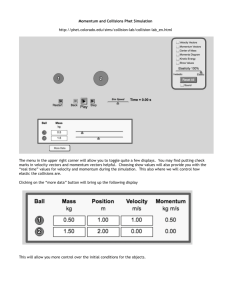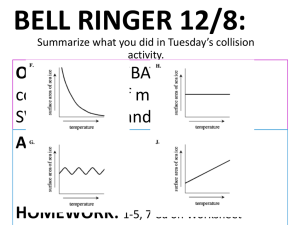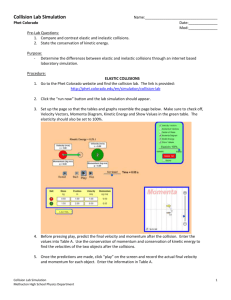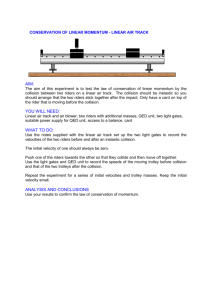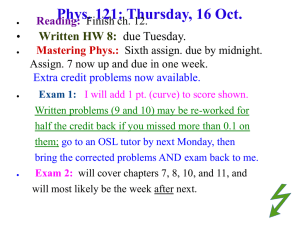z10 Collisions Phet Lab PHET Lab 11 Momentum
advertisement
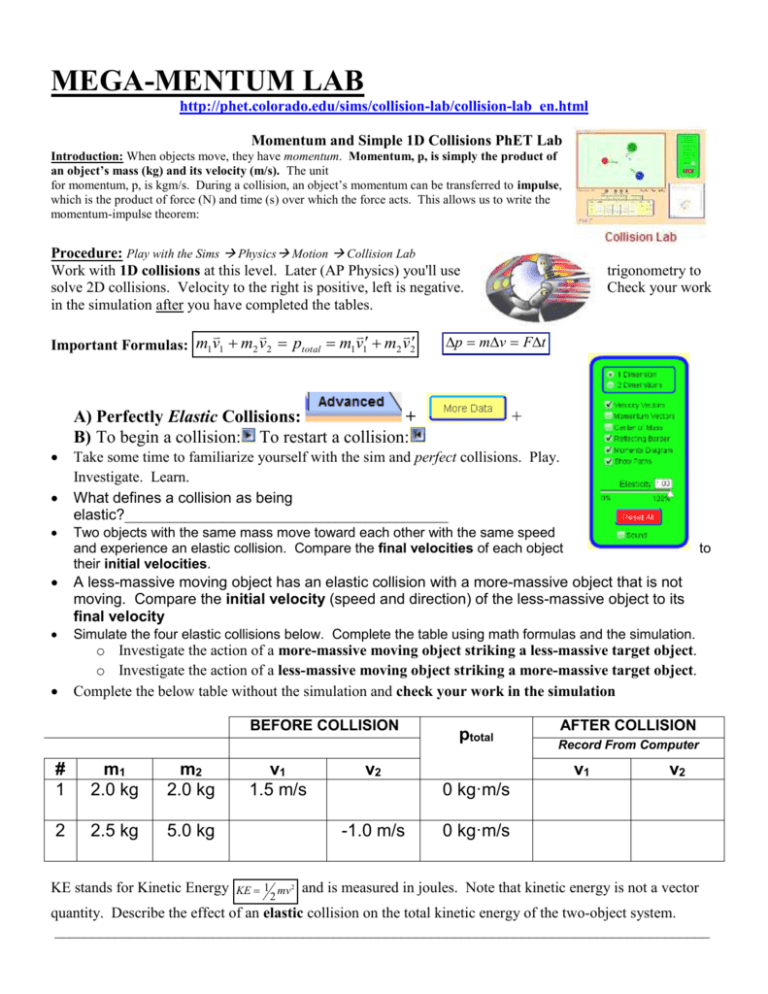
MEGA-MENTUM LAB http://phet.colorado.edu/sims/collision-lab/collision-lab_en.html Momentum and Simple 1D Collisions PhET Lab Introduction: When objects move, they have momentum. Momentum, p, is simply the product of an object’s mass (kg) and its velocity (m/s). The unit for momentum, p, is kgm/s. During a collision, an object’s momentum can be transferred to impulse, which is the product of force (N) and time (s) over which the force acts. This allows us to write the momentum-impulse theorem: Procedure: Play with the Sims Physics Motion Collision Lab Work with 1D collisions at this level. Later (AP Physics) you'll use solve 2D collisions. Velocity to the right is positive, left is negative. in the simulation after you have completed the tables. Important Formulas: m1v1 m2 v2 ptotal m1v1 m2 v2 p mv Ft A) Perfectly Elastic Collisions: + B) To begin a collision: To restart a collision: trigonometry to Check your work + Take some time to familiarize yourself with the sim and perfect collisions. Play. Investigate. Learn. What defines a collision as being elastic?___________________________________________ Two objects with the same mass move toward each other with the same speed and experience an elastic collision. Compare the final velocities of each object their initial velocities. to A less-massive moving object has an elastic collision with a more-massive object that is not moving. Compare the initial velocity (speed and direction) of the less-massive object to its final velocity Simulate the four elastic collisions below. Complete the table using math formulas and the simulation. o Investigate the action of a more-massive moving object striking a less-massive target object. o Investigate the action of a less-massive moving object striking a more-massive target object. Complete the below table without the simulation and check your work in the simulation BEFORE COLLISION # 1 m1 2.0 kg m2 2.0 kg 2 2.5 kg 5.0 kg KE stands for Kinetic Energy v1 1.5 m/s v2 AFTER COLLISION Record From Computer v1 v2 0 kg·m/s -1.0 m/s KE 1 mv2 2 ptotal 0 kg·m/s and is measured in joules. Note that kinetic energy is not a vector quantity. Describe the effect of an elastic collision on the total kinetic energy of the two-object system. _______________________________________________________________________________________ B) Perfectly Inelastic Collisions: Select: m1v1 m2 v2 v'12 m1 m2 + + m1v1before + m2 v2before = m1 + m2 vafter Complete the below table without the simulation an d check your work in the simulation. BEFORE COLLISION # 1 m1 2.0 kg m2 2.0 kg v1 1.5 m/s v2 0 2 3.0 kg 6.0 kg 1.5 m/s -0.75 m/s AFTER COLLISION ptotal Calculate v’ Before Computer C) Perfectly Inelastic 2DCollisions: Select:Advanced + + You will have to move the starting points around so they collide BEFORE COLLISION AFTER COLLISION ptotal Record From Computer Calculate p’ Before Computer ptotal # m1 m2 V2x V1y 1 2.0 kg 2.0 kg 1.5 m/s 1.7 m/s / / / / 2 3.0 kg 6.0 kg 1.5 m/s 0.5 m/s / / / / v1x /v1y /v2x /v2y

